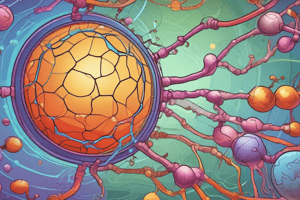Podcast
Questions and Answers
What is the primary function of the Na+ pump in nerve cells?
What is the primary function of the Na+ pump in nerve cells?
- To facilitate the transmission of nerve impulses (correct)
- To regulate the movement of molecules or ions across membranes
- To maintain osmotic balance with the solution outside the cell
- To synthesize macromolecules from monomer subunits
Which of the following is an example of chemical synthesis?
Which of the following is an example of chemical synthesis?
- The contraction of muscle cells
- The movement of cells during development
- The formation of polysaccharides from sugars (correct)
- The movement of molecules or ions across membranes
What is the primary function of the Ca2+ pump in muscle cells?
What is the primary function of the Ca2+ pump in muscle cells?
- To regulate the movement of molecules or ions across membranes
- To keep Ca2+ levels in the cells very low (correct)
- To maintain osmotic balance with the solution outside the cell
- To facilitate the transmission of nerve impulses
What is the primary role of membrane transport in the bird of paradise's dance?
What is the primary role of membrane transport in the bird of paradise's dance?
What is the estimated percentage of energy used by the brain to move Na+ and K+ across cell membranes?
What is the estimated percentage of energy used by the brain to move Na+ and K+ across cell membranes?
How do cells transform molecules and energy?
How do cells transform molecules and energy?
What is the primary function of membrane transport in cells?
What is the primary function of membrane transport in cells?
Which of the following is an example of evolutionary adaptation?
Which of the following is an example of evolutionary adaptation?
What is the primary mechanism by which cells regulate chemical synthesis?
What is the primary mechanism by which cells regulate chemical synthesis?
What is the primary function of energy processing in cells?
What is the primary function of energy processing in cells?
What is the evolutionary significance of advantageous mutations passed onto offspring?
What is the evolutionary significance of advantageous mutations passed onto offspring?
What is the primary function of regulation and signaling in cells?
What is the primary function of regulation and signaling in cells?
What is the primary function of energy processing in cells?
What is the primary function of energy processing in cells?
How do cells create ordered structures such as cells, organs, and tissues?
How do cells create ordered structures such as cells, organs, and tissues?
Which of the following is an example of cellular movement?
Which of the following is an example of cellular movement?
What is the primary function of macromolecule synthesis in cells?
What is the primary function of macromolecule synthesis in cells?
Which type of metabolic pathways involve breaking down complex molecules into simpler ones?
Which type of metabolic pathways involve breaking down complex molecules into simpler ones?
What is the purpose of energy coupling?
What is the purpose of energy coupling?
What is the role of enzymes in metabolic regulation?
What is the role of enzymes in metabolic regulation?
What happens to energy levels when an individual eats a crème egg after fasting?
What happens to energy levels when an individual eats a crème egg after fasting?
What is the energy currency of the cell?
What is the energy currency of the cell?
What is the purpose of anabolic pathways?
What is the purpose of anabolic pathways?
How are metabolic pathways regulated?
How are metabolic pathways regulated?
What is the result of catabolic pathways?
What is the result of catabolic pathways?
What is the primary role of the electron transport chain in cellular energy production?
What is the primary role of the electron transport chain in cellular energy production?
What is the relationship between free energy and entropy?
What is the relationship between free energy and entropy?
What is the primary function of free energy changes in cells?
What is the primary function of free energy changes in cells?
What is the primary characteristic of a system with high free energy?
What is the primary characteristic of a system with high free energy?
What is the primary role of the proton gradient in ATP synthesis?
What is the primary role of the proton gradient in ATP synthesis?
What is the primary function of ATP in cellular metabolism?
What is the primary function of ATP in cellular metabolism?
What is the primary role of cells in terms of energy?
What is the primary role of cells in terms of energy?
What happens to the entropy of the universe in every reaction that occurs in a cell?
What happens to the entropy of the universe in every reaction that occurs in a cell?
What type of energy is associated with an object in motion?
What type of energy is associated with an object in motion?
What is the condition for a reaction to occur spontaneously?
What is the condition for a reaction to occur spontaneously?
What is the first law of thermodynamics related to?
What is the first law of thermodynamics related to?
What type of reaction has a positive ΔG value?
What type of reaction has a positive ΔG value?
What type of energy is chemical energy an example of?
What type of energy is chemical energy an example of?
What is the purpose of the proton gradient across the mitochondrial membrane?
What is the purpose of the proton gradient across the mitochondrial membrane?
What type of energy is transformed during the process of cellular respiration?
What type of energy is transformed during the process of cellular respiration?
What is the role of ATP synthase in mitochondrial energy production?
What is the role of ATP synthase in mitochondrial energy production?
What is the energy currency of the cell?
What is the energy currency of the cell?
What is the energy source for the production of ATP in mitochondria?
What is the energy source for the production of ATP in mitochondria?
What is the purpose of the proton gradient across the mitochondrial membrane?
What is the purpose of the proton gradient across the mitochondrial membrane?
What type of metabolic pathway is involved in the breakdown of glucose to produce ATP?
What type of metabolic pathway is involved in the breakdown of glucose to produce ATP?
What is the primary function of ATP in cellular metabolism?
What is the primary function of ATP in cellular metabolism?
What is the result of ATP hydrolysis?
What is the result of ATP hydrolysis?
What is the role of enzymes in cellular metabolism?
What is the role of enzymes in cellular metabolism?
What is the characteristic of a reaction with a negative ΔG value?
What is the characteristic of a reaction with a negative ΔG value?
What is the purpose of catabolic pathways?
What is the purpose of catabolic pathways?
What is the result of coupling ATP hydrolysis with an endergonic reaction?
What is the result of coupling ATP hydrolysis with an endergonic reaction?
What is the approximate daily weight of ATP produced by an individual weighing 85 kg?
What is the approximate daily weight of ATP produced by an individual weighing 85 kg?
What is the primary role of enzymes in biological reactions?
What is the primary role of enzymes in biological reactions?
What is a characteristic of enzymes in terms of the reactions they catalyze?
What is a characteristic of enzymes in terms of the reactions they catalyze?
What is the effect of enzymes on the activation energy of a reaction?
What is the effect of enzymes on the activation energy of a reaction?
What is the significance of enzymes being highly regulated in the cell?
What is the significance of enzymes being highly regulated in the cell?
What is the result of harvesting all the ATP produced by the body in one day?
What is the result of harvesting all the ATP produced by the body in one day?
What is the reason why ATP hydrolysis increases the free energy of a molecule or protein?
What is the reason why ATP hydrolysis increases the free energy of a molecule or protein?
What is the role of ATP in coupled reactions?
What is the role of ATP in coupled reactions?
What is the energy change (ΔG) required to make ATP from ADP and Pi?
What is the energy change (ΔG) required to make ATP from ADP and Pi?
What is the primary function of ATP synthase?
What is the primary function of ATP synthase?
What is the result of ATP hydrolysis in a cell?
What is the result of ATP hydrolysis in a cell?
How does ATP fuel membrane transport?
How does ATP fuel membrane transport?
What is the purpose of energy coupling?
What is the purpose of energy coupling?
Why is ATP often referred to as the 'energy currency' of the cell?
Why is ATP often referred to as the 'energy currency' of the cell?
Flashcards are hidden until you start studying
Study Notes
Characteristics of Life
- Cells can transform molecules and energy to do work
- Three types of work:
- Movement
- Membrane Transport
- Chemical synthesis
Metabolism and Energy
- Metabolic pathways can be:
- Catabolic (break complex molecules into simpler ones, spontaneous, yield energy)
- Anabolic (build complex molecules from simple ones, non-spontaneous, cost energy)
- Energy coupling: energy derived from catabolic pathways drives anabolic pathways
- Energy carriers: ATP, NADH, NADPH
Metabolic Regulation
- Pathways regulated depending on energy needs of cell/organism
- Regulation via enzymes:
- Allosterically: regulation of enzyme activity through binding of molecules to specific sites on the enzyme, other than the active site, causing a conformational change that affects the enzyme's activity. This can either increase (activate) or decrease (inhibit) the enzyme's activity, depending on the type of allosteric regulator.
- Covalent modification is a type of regulation where an enzyme's activity is altered by the addition or removal of a chemical group, such as a phosphate molecule. This modification can either activate or inhibit the enzyme, depending on the specific modification and the enzyme involved. For example, phosphorylation, the addition of a phosphate group, can activate an enzyme, while dephosphorylation, the removal of a phosphate group, can inhibit it. This type of regulation is often reversible, allowing the cell to rapidly adjust enzyme activity in response to changing conditions.
- regulated enzyme regulation occurs when an enzyme's activity is influenced by genetic factors, such as genetic mutations, gene expression, or epigenetic modifications. This type of regulation can result in permanent changes to an enzyme's activity, as it affects the enzyme's structure or the genes that encode it. For instance, mutations in the gene coding for an enzyme can lead to altered enzyme activity, while epigenetic modifications, such as DNA methylation or histone modifications, can affect gene expression and, subsequently, enzyme activity.
Cell Movement and Membrane Transport
- Cells move using:
- Actin, a crucial protein enabling cell motility and migration, plays a vital role in cellular processes such as muscle contraction, cell division, and cytoskeleton organization.
- Cilia or flagella, which are hair-like structures propelled by dynein motors, facilitating cell movement and sensing the environment. (e.g., Tetrahymena, a ciliated protist)
- Membrane transport:
- Important for maintaining osmotic balance
- ~50% of energy used by brain is for Na+ and K+ transport
- Important for nerve cells and nerve impulses (Na pump)
- Important in muscle cells (Ca2+ pump)
Chemical Synthesis
- Important for growth and development
- Involves making macromolecules from monomer subunits:
- Polysaccharides from sugars
- Proteins from amino acids
- Nucleic acids from nucleotides
Energy Types and Transformations
- Energy can be classified into different types: light, electrical, heat, and potential energy
- Potential energy is related to structure or location, including chemical energy and proton gradient across a membrane
Energy Transformation
- Food is a source of chemical energy (potential energy), which is broken down via a metabolic pathway
- The energy from food is used to create a H+ gradient across the membrane of mitochondria (potential energy)
- The H+ gradient causes ATP synthase to rotate (kinetic energy), which is analogous to water flowing down a waterfall and spinning a water wheel
- The rotation of ATP synthase creates ATP (potential energy)
Energy Transformation (continued)
- ATP is used to drive many processes such as muscle contraction (kinetic energy)
- Plants transform light energy from the sun into sugars (potential energy) through photosynthesis
- Some prokaryotes useIn cellular respiration, cells utilize inorganic compounds, specifically oxygen, to generate energy by converting the chemical energy stored in glucose into ATP (adenosine triphosphate), the primary energy currency of the cell.
Thermodynamics
- Cells and organisms obey the laws of thermodynamics
- Cells need energy to move, move things across membranes, and for chemical synthesis (i.e., for work)
- Cells can't create energy, so they transform and transfer energy types
- Every reaction in a cell increases entropy in the universe (even if it increases order in the cell)
First Law of Thermodynamics
- Energy in the universe is constant (quantity, not quality or type)
- Energy can't be created or destroyed, but it can be transferred or transformed
- To do work, cells need energy, which is transformed from the sun, chemicals, or food to enable work
Types of Energy
- Kinetic energy: energy associated with movement, such as H2S, NH3, and Fe2+
- Potential energy: energy related to structure or location, including chemical energy and proton gradient across a membrane
Second Law of Thermodynamics
- Every energy transfer or transformation increases the disorder (entropy) of the universe
- Greater order equals lower entropy equals greater instability
- Higher free energy equals greater instability equals lower entropy
Free Energy and Work
- Free energy is a measure of something's stability
- Higher free energy (G) equals greater instability equals lower entropy (disorder)
- Lower free energy equals more stability equals higher entropy
- Free energy changes, specifically those that decrease Gibbs free energy (ΔG < 0), enable cells to perform various types of work, including mechanical, transport, and biosynthetic work.
- Free energy is the portion of a system's energy that can perform work when temperature and pressure are uniform throughout the system
ATP and Energy
- ATP is a cell's energy shuttle
- ATP hydrolysis is an exergonic reaction, which means it releases energy and is often coupled with endergonic reactions
- This coupling occurs through the loss or transfer of a phosphate group, making phosphorylated intermediates more reactive
Structure of ATP
- ATP is composed of an adenine base, a ribose sugar, and three phosphate groups
- The bond between the adenine base and the ribose sugar forms adenosine
- The addition of phosphate groups to adenosine forms a nucleotide
- The triphosphate structure of ATP is important for its energy-carrying role
ATP Hydrolysis and Free Energy
- ATP hydrolysis releases 7.3 kcal/mol of energy
- The negative ΔG (change in free energy) indicates that ATP hydrolysis is a spontaneous process
- The release of energy is due to the more stable state of ADP and Pi compared to ATP
ATP in the Cell
- In the cell, ATP hydrolysis is often coupled to other reactions, such as membrane transport, to increase the reactivity of molecules or proteins
- The energy released from ATP hydrolysis drives these reactions, making them more favorable
Energy Coupling
- ATP hydrolysis can fuel membrane transport, such as the movement of Na and K ions across the membrane
- This process involves a conformational change in the pump protein, allowing ions to move across the membrane
Coupled Reactions
- Phosphorylation of glutamic acid by ATP makes it more reactive, allowing it to join with ammonia to form glutamine
Importance of ATP
- ATP is essential for various cellular processes, including movement, transport, and chemical synthesis
- Motor proteins, Na+ and Ca2+ pumps, and coupled reactions all rely on ATP for energy
ATP Cycle
- ATP is generated from ADP and Pi through the process of cellular respiration
- Energy is extracted from electrons passed through proteins during respiration, which is then used to generate ATP
Enzymes
- Enzymes are biological catalysts that speed up reactions without changing the equilibrium position
- They are highly specific and regulated, allowing for metabolic control
- Enzymes lower the activation energy for a reaction, making it more favorable
Studying That Suits You
Use AI to generate personalized quizzes and flashcards to suit your learning preferences.




